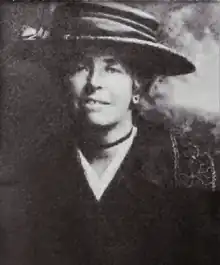
Maud Edith Cunnington CBE (née Pegge; 24 September 1869 – 28 February 1951) was a Welsh archaeologist, best known for her pioneering work on some of the most important prehistoric sites of Salisbury Plain.
Early life, education, and marriage
Maud Pegge was born at Briton Ferry in Glamorgan, to Catherine Milton Leach and her husband Charles Pegge, a doctor who ran Vernon House, the last privately owned asylum in Wales. She was one of seven children. Her older brother Edward Pegge followed their father into medicine as a doctor; he was also a notable rugby player and Welsh international.
Pegge was educated briefly at Cheltenham Ladies' College.[1] In 1889, she married Ben Cunnington. An archaeologist, he served for years as a volunteer, honorary curator of Devizes Museum. They had a son, Edward, who was killed in the First World War.
Career
From 1897, Maud Cunnington carried out early rescue archaeology work during development in Wiltshire, England. Together with her husband Ben, an archaeologist, she participated in conducting full excavations in that county at some of the most important sites in British archaeology. These included the first known Neolithic causewayed enclosure at Knap Hill, the Iron Age village at All Cannings Cross, West Kennet Long Barrow, Figsbury Ring, Woodhenge (near Stonehenge),[2] and The Sanctuary. This last monument she rediscovered, as it had been lost since William Stukeley saw it in the eighteenth century. The Cunningtons bought the sites of Woodhenge and The Sanctuary, and gave these properties to the nation.[3]
In 1912, near Avebury, she excavated and re-erected one of the two surviving stones (the Longstones) in the Beckhampton Avenue,[4] and one of the stones in the West Kennet Avenue.[5]
In 1931, Cunnington was elected president of the Wiltshire Archaeological and Natural History Society,[6] the first woman to hold that position.[7] In addition to technical reports, she published a short handbook, Avebury: A Guide (1931).[8] She also wrote and published a children's guide to Devizes Museum.[9]
Personal life and honors
Maud Cunnington was named a Commander of the Order of the British Empire (CBE) in the 1948 Birthday Honours[10] for services to archaeology, the first woman archaeologist to receive the honour. However, she had limited mobility since 1947, and had developed Alzheimer's disease, so she never knew of the accolade. When she died at home a few years later, she left almost all her property (worth £14,000) to Devizes Museum (now Wiltshire Museum). This provided for a salaried curator to be appointed for the first time. Her husband had died before her.[1]
References
- 1 2 Rundle, Penelope (2004), "Cunnington [née Pegge], Maud Edith (1869–1951)", Oxford Dictionary of National Biography, Oxford University Press, doi:10.1093/ref:odnb/45470
- ↑ Parker Pearson, Mike (2014). Stonehenge: A New Understanding: Solving the Mysteries of the Greatest Stone Age Monument. Workman Publishing. pp. 83–85. ISBN 9781615191932.
- ↑ "Six Groundbreaking Female Archaeologists". English Heritage. Retrieved 22 November 2021.
- ↑ Historic England. "Avebury Long Stones (1008104)". National Heritage List for England. Retrieved 27 July 2021.
- ↑ de Bruxelles, Simon (18 February 2003). "Rock of ages was turned on its head by angry rival". The Times. London.
- ↑ "78th General Meeting, July 1931". Wiltshire Archaeological and Natural History Magazine. 45 (155): 470. 1931 – via Biodiversity Heritage Library
 .
. - ↑ Champion, Sara (2005). "Women in British Archaeology: Visible and Invisible"". In Diaz-Andreu, Margarita; Sorensen, Marie Louise Stig (eds.). Excavating Women: A History of Women in European Archaeology. Routledge. p. 177. ISBN 9781134727766.
- ↑ Cunnington, Maud E. (1931). Avebury: A Guide.
- ↑ Greaney, Susan (April 2018). "Maud Cunnington at Stonehenge". English Heritage Members' Magazine. English Heritage. p. 62.
- ↑ "No. 38311". The London Gazette. 10 June 1948. p. 3374.
Additional sources
- Julia Roberts, "'That Terrible Woman': The Life, Work and Legacy of Maud Cunnington" Wiltshire Archaeological and Natural History Magazine (2002): 46–62. Via Internet Archive.